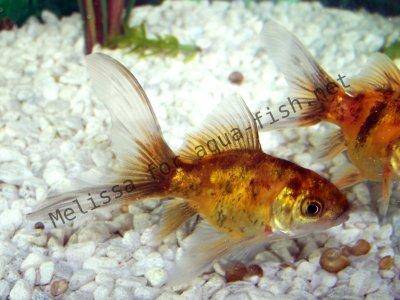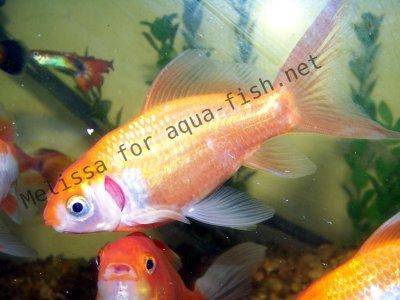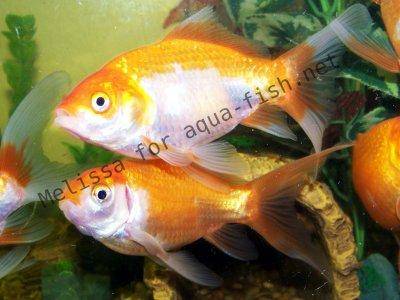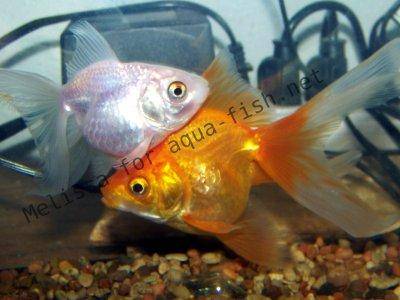Before You Buy a Goldfish - Tips, Pictures, Answers and Forum
Quick links - Answers
Brief Description
This page reveals all facts that one should know before purchasing Goldfish; You'll also find FAQ with answers attached at the end of the article and forum where we'd love to hear about your Goldfish! Share experiences or ask questions - we'll gladly answer!
Goldfish have been bred for over a thousand years for the sake of observation enjoyment. The art of breeding the finest specimens of goldfish first started in Asia and was later picked up in Europe. Breeders aimed to produce the highest quality of colors and shapes ever found on a goldfish. Because this type of fish has been bred so rigorously for all those years, you will never find one for sale that has not been born in captive breeding. An amateur aquarist could decide that he or she would like to raise goldfish in a pond or aquarium but there are a lot of factors to consider before getting started in this hobby. The beginner aquarist should first learn about the different types of goldfish to find out which varieties are hardy and easy to care for. A little bit of research as to what different varieties of goldfish to purchase and their specific needs is necessary for a successful pond or aquarium. Without the proper knowledge of water chemistry and conditions the inexperienced hobbyist might stumble upon some pretty devastating mishaps with their new pets. With a little bit of information you can make a well informed decision on what kind of goldfish you want to buy for your aquarium or pond.
Goldfish Varieties
There are many different varieties of goldfish and each unique trait is as valued as the next in the aquarium industry. Goldfish can possess over exaggerated features such as bubble eyes, hunched backs, double fins, round bodies, outstanding scales, puffy caps or nostrils, and fancy colors. Each and every goldfish variety is admired for its unique traits. Forgive me if there are a few varieties that I neglect to mention but I will try to cover them all in this article. The key to raising goldfish is, knowing the individual varieties, what makes them special and what their specific needs are. Once you have done your research, you can decide what varieties of goldfish are right for you.
Single Tail Varieties:
- Common: The common goldfish is the most basic and common of all the goldfish varieties, thus its nickname the “common goldfish”. They are the most resilient of all the different goldfish species and can live up to 30 years and reach a mature size of 24 inches in a pond. This is the original goldfish that has been selectively bred in order to form all the different varieties of “fancy” goldfish. The common and comet goldfish are usually found in aquarium retail stores as feeder goldfish. The lower quality specimens are the ones sold as feeders because breeders will not use them for breeding and hobby aquarists would not want to raise them. When shopping for a common goldfish, be sure to check that the gill covers are completely formed and that they are not hunch backed. Those are signs of defective specimens.
- Comet: The comet goldfish is essentially the common goldfish with longer fins. This fish is just as hardy as the common goldfish but their fins are more likely to get nipped at due to their length. The body shape and length as well as all the color combinations are the same as the common goldfish. The comet goldfish can potentially reach a mature size of approximately 22 inches and can live up to 20 years if it is well cared for. This only happens if this type of goldfish is raised in a pond. Be sure that the fins are nicely in tact before purchasing these fish. If the fins are shredded the fish could be stressed out and may not survive a trip to a new aquarium.
- Shubunkin: The shubunkin goldfish is very similar to the comet goldfish in terms of their body and fin shape, although sometimes you will be able to find a double tailed shubunkin. Their calico colors of red, white, orange, black and blue set them apart from the common comet goldfish. These shubunkin goldfish reach a mature size of 8 to 12 inches for up to 25 years. This fish can also be found in a short fin variety. This variety is not quite as resilient as the common goldfish but is still quite hardy when compared to other goldfish varieties. Although the colors are not as prominent in the pond as the deep orange coloration of the common and comet goldfish, they still survive well and can thrive in a pond environment.
Fancy Tail Varieties:
- Wakins: The wakins goldfish is also known as the double tail goldfish because of their double caudal tail fin which is divided. The wakins goldfish retain the same body shape and color combinations as the common goldfish. Each segment of this goldfish’s double tail is positioned closely together as opposed to wide set, so the tail appears to be thinner than the butterfly tail variety of goldfish.
- Jikins: The jikins goldfish, also known as the butterfly goldfish is a double tailed goldfish that retains the body shape and color combinations of the common goldfish. This fish is different from the wakins or double tailed goldfish because each segment of this goldfish’s tail is connected closer to the tip and positioned to spread out into a wider set tail formation. Because the two segments of the tail are connected almost to the tip, the tail on this goldfish variety appears to be butterfly shaped from up above which explains the name “butterfly tail“. The jikins goldfish is bred from the wakins goldfish and will most times have less dramatic coloration. The ideal jikins goldfish which can be very expensive will have a white body with red lips, fins and tail.
- Fantail: The fantail goldfish is named for its double tail configuration in addition to their pointed faces, round bodies. The fan shaped double tails along with their cute body form put them in the category of “fancy” goldfish. These fantail goldfish come in a variety of different color combinations, both iridescent and metallic. Sometimes these fantail goldfish can be found with telescope eyes but most times they have normal eyes. These goldfish are pretty resilient when compared to the other fancy types of goldfish but they still have the tendency to contract swim bladder disorder. To prevent this do not let water temperature drop below 50°F. This type of goldfish does not have very much trouble with their swimming abilities as some of the other fancy varieties do. They have the potential to reach 14 inches long and live up to 12 years.
- Nymph: The nymph goldfish shares the same body shape as the fantail goldfish but it lacks the double tail. This goldfish is essentially the same fish as the fantail goldfish so it comes in all the same color combinations. The single anal and caudal fins cause the nymph to appear to be a shorter, rounder common goldfish but it is actually born to the fantail or veil tail goldfish varieties. The nymph goldfish can reach a length of 14 inches and live up to 12 years.
- Veil tail: The veil tail goldfish is named for its long flowing fins. This variety of goldfish retains a round, elongated body shape and it comes in all the different goldfish color combinations. The ideal veil tail goldfish will have a dorsal fin that will start at the highest point of the veil tail’s back and be as tall as the height of the goldfish’s body. This makes for a well proportioned veil tail goldfish. Since their fins are so long and so delicate the veil tail goldfish should have plenty of room to swim without obstacles to get caught on. This fish can be relatively hardy if their fins are well cared for and they have the potential to grow up to 10 inches in length and live up to 16 years.
- Ryukin: The ryukin goldfish comes in all the usual goldfish color combinations although the red and silver combination is in highest demand and. The calico ryukin is very common and exhibits all the usual colors of red, black, white, blue and orange. These fish have pointed heads, high backs and round bellies. Their double fan tails put them in the fancy goldfish classification even though their eyes are always normal. The ryukin goldfish grow to a maximum of 10 inches which make them a great alternative to raising koi fish without having to have the large space requirements that koi fish demand. They have a life span of up to 25 years and can be fairly robust goldfish.
- Oranda: The oranda goldfish is quite a fish to look at because of their extremely round bellies and short bodies. They have fancy flowing tail and dorsal fins as well as their thick hoods that cover their heads and faces almost to the point where you cannot see their eyes. The oranda goldfish come in a variety of colors and color combinations. The hood on an oranda goldfish takes awhile to develop and may start to appear as white spots that look like ick before forming into a full hood. There is a redcap variety of the oranda goldfish which is different from other orandas because unlike the oranda hood that covers the face and head, the cap is confined to growing on the top of a head and not at all on the face of the goldfish. Ideal specimens of the oranda goldfish should have long flowing fins and a nice even leveled hood that does not cover the eyes of the fish. This fish can live up to 25 years and grow up to 10 inches long.
- Telescope eye: The telescope eye goldfish, which is also called dragon eye goldfish, is known for their protruding eyes. These fish have high dorsal fins and short, round bodies. This is a resilient goldfish that can live up to 25 years old and reach potentially 8 inches in length. The telescope eye goldfish come in all the different color combinations which make it possible for their eyes to exhibit different color variations as well. It is uncommon for the eyes on this fish to have colors contrasting the colors of the head. The telescoped eyes will come in a variety of sizes but the ideal fish should have symmetrical eyes and long flowing fins.
- Moor: The moor goldfish has telescope eyes and comes in a variety of different colors. The body shape of the moor goldfish is the same as the veil tail goldfish. The highest prized of the moors is the black moor which is completely black all over and may sometimes have bronze scales. The black moor goldfish is a great contrast when added to an aquarium with goldfish of other colors. These fish are slow moving, clumsy swimmers so they do not do great in a pond or aquarium with aggressive fish. Moors can live for up to 25 years and reach a length of 10 inches.
- Lion head: The lion head goldfish is named for its lion-like appearance when it is fully mature. A hood develops on this fish just like the ranchu and the oranda but it is noticeably more prominent than the other varieties of goldfish. When fully mature, the hood of this fish should fully cover its head with the exception of the eyes. The lion head has a double tail fin and lacks the dorsal fin which gives it a smooth back. Although the lion head has a round belly, it has the longer body than the ranchu goldfish. The ideal lion head goldfish should have an elongated, straight back without a hunch to it. This fish can reach up to 8 inches in length and live up to 15 years old.
- Ranchu: The ranchu goldfish looks very similar to the lion head goldfish with two very minor differences. First, the body shape of a ranchu is slightly rounder and not as long. Second, the hood on the ranchu goldfish is not quite as defined as the hood on the lion head goldfish. When searching for a ranchu goldfish be sure to check the curvature of the back; there should be no humps. Sometimes you will see as much as a 90° curvature of its back, otherwise this fish can grow up to 8 inches in length. These fish are not very resilient and cannot withstand colder temperatures so they will need to be kept in a temperature regulated aquarium. The life span of this fish is 15 years but most times they will not even live that long.
- Pompon: The pompon goldfish are named for the nasal flaps which appear larger on this variety of goldfish than on any other. The size of pompons varies from fish to fish but on a single fish, both pompons should be symmetrical when looking for a good specimen to purchase. The highest in demand of all the pompon goldfish is the “red magpie” which is characterized by the black coloration of the goldfish’s face contrasting with the bright orange pompons. There are other color combinations available as well. This fish can reach a potential of 8 inches in length and live up to 25 years old.
- Pearl scale: The pearl scale goldfish is named for the visual effect of their scales that reflect light to appear pearl-like. Each scale is curved more than normal scales so that the center appears pearly white. The pearl scale goldfish tends to be a little smaller than other varieties of goldfish, with exaggerated round bodies and double caudal fins. This variety of fish does not swim especially well so they are best kept in calm aquariums with non-aggressive fish. These fish are not very hardy so extreme care should be taken when raising these fish. They have the potential to reach 8 inches in length and they can live for about 20 years if they are very well cared for.
- Bubble eye: The bubble eye goldfish name is quite self explanatory. It is named for the liquid filled bubbles positioned just below the eyes. The bubble eye goldfish has the same elongated round body as the lion head goldfish. They too lack the dorsal fin and have the double caudal tail fin. A well proportioned bubble eye goldfish will have symmetrical bubbles under each eye and the width of the bubbles on the head should equal the same as the length of the body. Because the bubble sacs are so delicate, this variety of goldfish should be placed in a spacious aquarium with non-aggressive fish. It is possible for the fluid filled sacs to be punctured and deflated so extreme caution should be taken when caring for this fish. If special care is taken with the surroundings of this fish the fluid filled sacs can potentially repair heal. The bubble eye goldfish is available in all the different color combinations. They can reach 6 inches in length and live for up to 10 years long.
- Celestial: The celestial goldfish is named for their bubble eyes that point upward as if they are permanently gazing at the stars. These goldfish, like the lion head goldfish, have elongated bodies, round bellies, double tail configuration and they lack a dorsal fin. It is very common to find this type of goldfish with a deep orange coloration even though it is available in other color combinations. A good specimen of the celestial goldfish should have symmetrical eyes both in angle and position. Also available is the celestial pompon goldfish which have the celestial eyes as well as the pompon nasal flaps. This fish has a short life expectancy of 7 years and they can reach up to 10 inches in length.
The fancy goldfish with all the unique traits are much more likely to contract swim bladder disorder which is a condition in which the fish becomes disoriented and loses its ability to swim upright. The more a goldfish is bred to exhibit traits different from the common goldfish the less resistant the fish becomes to all the different diseases that can ail a goldfish. When searching for your new goldfish, be sure to observe their swimming ability for a little bit while still in the store. Although the fancier types of goldfish are not as graceful as other fish, they should still be able to swim around without too much trouble. Check all of the fins to see that they are still in tact and not shredded or rotten. Look at the eyes to be sure that they are clear and undamaged; if they look cloudy or uneven it would be best not to purchase the goldfish. Be sure to check that their gill plates are completely covering their gills; some fish are born defective with incomplete gill covers.
When choosing the right specimens to take home to your pond or aquarium, be sure to first observe the conditions of the tanks in the pet store. By looking closely at the store’s display tanks you will be able to see if the fish are well cared for and free of disease. If most or all of the fish tanks look diseased and unclean it would be best to move on to another aquatic retail store. If you purchase healthy, well cared for goldfish you will have a better chance at goldfish raising success.
Undesirable colors on a goldfish
Undeveloped Gill Coverings – The gills are exposed

Sources
- firsttankguide.net
- ponddoc.com
- kokosgoldfish.com
- goldfishconnection.com
- Focus on Freshwater Aquarium Fish by Geoff Rogers and Nick Fletcher
- Encyclopedia of Aquarium and Pond Fish by David Alderton
Recommended reading about Goldfish within Aqua-Fish.Net
- Goldfish - Carassius auratus auratus
- Goldfish
- Goldfish Aquarium
- Goldfish Breeding
- Goldfish and Water Quality
- Diseases of Goldfish
- The Underrated Goldfish
Additional questions and answers related to raising Goldfish
On March 17th 2011 we've updated this page by merging questions that were originally published at aqua-fish.net/answers with the article above in order to put all information together. If you cannot find answer on your question within this page, then feel free to use a form at bottom to ask questions, share experiences or simply make suggestions! (some questions may be partially answered above)
-
What type of water do Goldfish prefer?
Answer: Their demands aren't very specific. You can keep them in a 15°C water as well as in a 25°C water. pH can vary between 6 and 8, and dGH can be from 4 to 18. Just bear in mind that the conditions shouldn't change too often.
-
Why shouldn’t goldfish be kept in bowls?
Answer: In many countries goldfish bowls are now being outlawed as they are too cramped for the fish to enjoy life and the water cannot always be filtered properly.
-
Why do my goldfish breathe so fast?
Answer: This is normally a sign of low oxygen levels in the water. This is causing the gold fish to increase their gill movements to take in more of the small amounts of oxygen available. Often this occurs in ponds when the air temperature increases and oxygen levels drop. Aerating the water will solve this problem.
-
What should I feed my goldfish to get strong red colors?
Answer: You can feed the goldfish feeds that contain carotene but they will only have short term coloration success. If the fish is happy then it will color up naturally anyway.
-
What equipment do I need to keep a goldfish?
Answer: Goldfish require a tank large enough to give them plenty of swimming space and room to grow as they mature. They produce a lot of waste so a good filter will be needed in the tank as well.
-
What size of tank do you need for goldfish?
Answer: Common goldfish require at least 40 liters of water each. Multiply this figure by the number of fish that you wish to keep and it will give you the size of the tank required.
-
Which fish are compatible with shubunkin goldfish?
Answer: Comets, ordinary goldfish, fantails, virtually any coldwater fish should be alright with these fish.
-
When can I add goldfish to a new aquarium?
Answer: No fish should be added to a new aquarium, the filters need cycling to deal with the waste that the goldfish will produce. Testing your water for ammonia, nitrites, and nitrates will tell you when the tank is ready for fish.
-
What do baby goldfish look like?
Answer: They look like very tiny adult gold fish, most of the time they are less colorful, oftentimes they will start out life silver or black.
-
What causes goldfish to have labored breathing?
Answer: This can be caused by poor water conditions, bacterial infection, or other diseases such as ick. Test your water for pH, ammonia, nitrates and nitrites, if these check out OK, then watch for other symptoms to determine what you should treat for.
-
When do goldfish reach maturity?
Answer: Goldfish will become fully mature at the age of one year.
-
When will my Oranda goldfish grow a hood?
Answer: The hood, commonly known as a ”wen”, will start to develop between 3-4 months of age. It will not become pronounced until the fish is 1- 2 years old.
-
What does a goldfish wound look like when it is healing?
Answer: The initial wound will look red and sore, as it starts to heal the edges of the wound will look similar to scar tissue and the redness will subside. Fish heal very quickly if treated properly.
-
What do goldfish look like when they are laying eggs?
Answer: The female will have a swollen belly and her vent underneath will be swollen. The male will have spots on his gill plates if he is ready to fertilize the eggs.
-
My goldfish have swollen eyes and white spots, what disease causes this?
Answer: The swollen eyes are caused by a common goldfish disease called Popeye. This is treated quite easily by using a suitable medication found in the pet stores. Dropsy can also bring on this symptom and is not so easy to treat.
-
Which types of goldfish thrive in warmer water?
Answer: Since goldfish are not warm water species, they should not be kept in warm water. If you want goldfish that will be least sensitive to temperature do not get a fancy type. Stick with the common or comet goldfish because they tend to be hardier than the fancy types.
-
Do goldfish swell when they are full of eggs?
Answer: As with most species of fish, egg carrying females will appear swollen around the abdomen.
-
What is the life expectancy of a red head gold fish?
Answer: The life expectancy of any fancy goldfish, if given the correct living conditions, should be between 5 – 10 years.
-
Where can I buy redcap oranda goldfish?
Answer: These are a common gold fish variety that can be found at most pet retailers, and high quality specimens can be purchased online at www.aquariumfish.net for about $13 USD.




